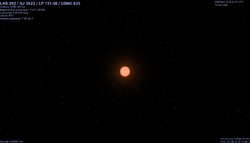LHS 292
 Generic rendering of LHS 292 flare star | |
| Observation data Epoch J2000 Equinox J2000 | |
|---|---|
| Constellation | Sextans |
| Right ascension | 10h 48m 12.6s[1] |
| Declination | −11° 20′ 14″[1] |
| Apparent magnitude (V) | 15.73[1] |
| Characteristics | |
| Spectral type | M6.5 V |
| Apparent magnitude (J) | 8.9[2] |
| B−V color index | 2.10 |
| Variable type | Flare star |
| Astrometry | |
| Parallax (π) | 220.30 ± 3.60[1] mas |
| Distance | 14.8 ± 0.2 ly (4.54 ± 0.07 pc) |
| Absolute magnitude (MV) | 17.45[1] |
| Details | |
| Mass | 0.08[1] M☉ |
| Radius | 0.11? R☉ |
| Luminosity | 0.00069[3] L☉ |
| Temperature | 2650-2900[3] K |
| Other designations | |
LP 731-58, GJ 3622, GCTP 2516.02 | |
| Database references | |
| SIMBAD | data |
LHS 292 is a red dwarf in the constellation Sextans. It is far too faint to be seen with the unaided eye and requires a large amateur telescope to be seen visually. It lies relatively close to the Sun at a distance of about 14.8 light years. It is a flare star, which means it can suddenly increase in brightness for short periods of time.
It has the space velocity components [U, V, W] = [28, −16, −14] km/s.[4]
See also
References
- 1 2 3 4 5 6 Research Consortium On Nearby Stars, GSU (2007-09-17). "The One Hundred Nearest Star Systems". RECONS. Retrieved 2007-11-06. External link in
|journal=(help) - ↑ "LHS 292". SIMBAD Astronomical Database. Retrieved 2012-06-12.
- 1 2 Golimowski; et al. (2004). "L' and M' Photometry of Ultracool Dwarfs". The Astrophysical Journal. 127 (6): 3516–3536. arXiv:astro-ph/0402475
 . Bibcode:2004AJ....127.3516G. doi:10.1086/420709.
. Bibcode:2004AJ....127.3516G. doi:10.1086/420709. - ↑ Reiners, A.; Basri, G. (November 2009). "A Volume-Limited Sample of 63 M7-M9.5 Dwarfs. I. Space Motion, Kinematic Age, and Lithium". The Astrophysical Journal. 705 (2): 1416–1424. arXiv:0909.4647
 . Bibcode:2009ApJ...705.1416R. doi:10.1088/0004-637X/705/2/1416.
. Bibcode:2009ApJ...705.1416R. doi:10.1088/0004-637X/705/2/1416.
Notes
External links
This article is issued from Wikipedia - version of the 6/1/2016. The text is available under the Creative Commons Attribution/Share Alike but additional terms may apply for the media files.